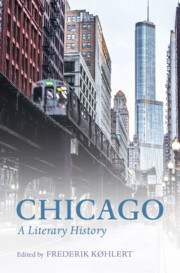Book contents
- Chicago: A Literary History
- Chicago
- Copyright page
- Contents
- Figures
- Contributors
- Acknowledgments
- Introduction: The Literary History of Chicago
- Part I The Rise of Chicago and the Literary West
- Part II Business Unusual: A New Urban American Literature
- Part III Radicalism, Modernism, and the Chicago Renaissance
- Part IV A City of Neighborhoods: The Great Depression, Sociology, and the Black Chicago Renaissance
- Chapter 17 Chicago Ecology and James T. Farrell’s Studs Lonigan
- Chapter 18 Chicago Gets the Blues: Migration, Depression, and the Black Renaissance
- Chapter 19 Black Chicago: Richard Wright’s South Side
- Chapter 20 Life in Bronzeville: Humanism and Community in the Work of Gwendolyn Brooks
- Chapter 21 Hustlers, Junkies, and Prostitutes: Nelson Algren’s White Slums
- Chapter 22 From Emptyland to Uncanny City: Saul Bellow’s Jewish Chicago
- Part V Traditions and Futures: Contemporary Chicago Literatures
- Selected Bibliography
- Index
Chapter 20 - Life in Bronzeville: Humanism and Community in the Work of Gwendolyn Brooks
from Part IV - A City of Neighborhoods: The Great Depression, Sociology, and the Black Chicago Renaissance
Published online by Cambridge University Press: 02 September 2021
- Chicago: A Literary History
- Chicago
- Copyright page
- Contents
- Figures
- Contributors
- Acknowledgments
- Introduction: The Literary History of Chicago
- Part I The Rise of Chicago and the Literary West
- Part II Business Unusual: A New Urban American Literature
- Part III Radicalism, Modernism, and the Chicago Renaissance
- Part IV A City of Neighborhoods: The Great Depression, Sociology, and the Black Chicago Renaissance
- Chapter 17 Chicago Ecology and James T. Farrell’s Studs Lonigan
- Chapter 18 Chicago Gets the Blues: Migration, Depression, and the Black Renaissance
- Chapter 19 Black Chicago: Richard Wright’s South Side
- Chapter 20 Life in Bronzeville: Humanism and Community in the Work of Gwendolyn Brooks
- Chapter 21 Hustlers, Junkies, and Prostitutes: Nelson Algren’s White Slums
- Chapter 22 From Emptyland to Uncanny City: Saul Bellow’s Jewish Chicago
- Part V Traditions and Futures: Contemporary Chicago Literatures
- Selected Bibliography
- Index
Summary
This chapter examines Gwendolyn Brooks’s representation of everyday African American lives in what was at midcentury affectionately known as “Bronzeville.” Her literature elevates the ways these people – especially Black women – found meaning and value in their regular lives, even as they lived in the shadow of a disinterested and segregated city. With a focus on Brooks’s first collection of poetry, A Street in Bronzeville, and her novel, Maud Martha, this chapter explores how Brooks’s writing exemplifies humanism and places it in the same populist Chicago tradition of Carl Sandburg, while also maintaining ties to the sociologically informed neighborhood writing of Richard Wright, James T. Farrell, and Nelson Algren. Even though Brooks did not define herself as an African American humanist, she engages with some of its core concepts. Namely, she shows how Black people challenge Christian ideals and how they process death and loss without relying on religious doctrines. Instead, Brooks’s characters look inward and toward their community for aid and redemption.
Keywords
- Type
- Chapter
- Information
- ChicagoA Literary History, pp. 284 - 294Publisher: Cambridge University PressPrint publication year: 2021

